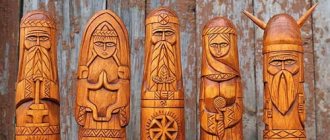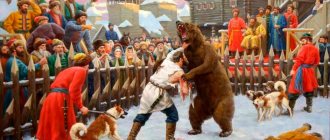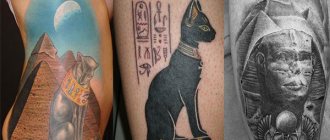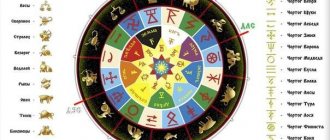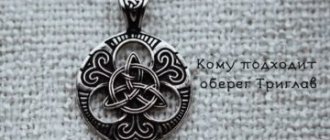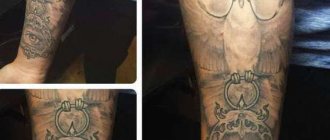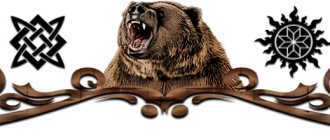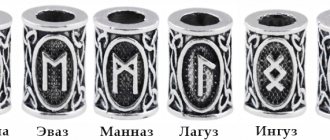02/10/2021 1,663 Charms
Author:Helga
To demonstrate hidden abilities and protect against negative influences, images of gods or runic symbols are most often chosen from Slavic tattoos. When choosing a deity or totem animal, you should focus on your own qualities that need to be strengthened or suppressed. In the case of runes, you should make sure that they correspond to the canonical writing at the sketch stage, since when turned upside down they can take on the opposite meaning.
[Hide]
History of the development of Slavic tattoos
Little is known about the most ancient stages of the development of Slavic tattooing art. The only thing that was reliably established was that body designs were widespread among both men and women and reflected the beliefs of the people of that time. According to them, with the help of a tattoo one could protect oneself from the machinations of “dark forces”, become more resilient and stronger.
The main difference between traditional Slavic designs was the belief that they should not be applied before the age of 33. It was believed that during this period the main processes of development of the physical body, which a tattoo could distort, were completed.
With the advent of Christianity, painting on the body was completely prohibited, but in recent years, largely due to the weakening position of the church, there has been a real renaissance of this ancient art of decorating one’s own body.
Sketches of animal and plant tattoos
The Slavs depicted the following totem animals on their bodies:
- Bear . Symbolizes strength and power, helps the weak and offended. It is considered an assistant to men, giving health for procreation.
- Wolf . It is associated with loyalty, but at the same time with loneliness. It is better to depict a wolf with its mouth closed. In this case, he gives peace and wisdom. But the open mouth symbolizes aggression, most often unjustified.
- Crow . Develops wit, helps to become more decisive. It means dark forces, but at the same time protects a person from them.
- Ladybug . _ This insect is associated with the sacrifice that mothers make for their children. Gives abundance and fertility.
- Grasshopper . Symbol of longevity and prosperity. Promotes self-knowledge and self-improvement.
- Bee . Represents hard work. It sets you up for positive thinking and directs you on the right path, which will lead you exactly to the place where a person should be.
- Spider . The Slavs associated the spider with a quiet life and material wealth. It protected against illness and injury.
Plants most often depicted were:
- Tree . A sign of fertility, development of vitality. Typically, trees with thick trunks were chosen, as they symbolized long life, wisdom and tranquility. Trees with dense foliage were always depicted so that there would be prosperity in life.
- Fern . Protected from dark otherworldly forces. Gives a person powerful intuition that allows him to move in the right direction. The intertwined leaves meant the tricks of fate that a person could easily cope with.
Gallery of examples of photo tattoos for sketches:
Grasshopper Tree Wolf Bear on the arm Spider on the shoulder
Types and meaning of Slavic tattoos
In this direction of tattooing, many different signs, patterns and designs are used that carry deep meaning and are distinguished by beauty and aesthetics.
Signs - amulets
These are special symbols, often quite complex, the main purpose of which is to protect the wearer or attract success and luck into his life. The most popular include:
- Sign of Veles. This is a symbol of the protector of nature, the patron of secret knowledge. According to beliefs, it brings prosperity and good luck.
- Gromovik. One of the variants of the solar symbol, responsible for self-confidence, is a purely masculine sign.
- Molvinets. The main function is to dispel evil thoughts directed at the wearer, protection from damage and the evil eye.
- Kolyadnik. Another popular version of the male solar symbol, according to legend, bestows wisdom and good luck in battle.
Gods of the Slavic pantheon
The Slavic pantheon of pagan gods was in many ways similar to the Scandinavian one; the main gods were considered Rod, the creator of the world, and Perun, the lord of lightning. It is their images that are most often used for tattooing.
Other gods, such as Yarilo and Khors, are no less popular; each of them was responsible for certain natural processes.
Slavic runes
Initially they were used for writing, but later their sacred meaning came to the fore. Scientists believe that previously the number of runes used was greater, but only eighteen have survived to this day.
Runes can be applied in the form of a tattoo individually or in complex compositions. The main thing is to correctly choose the semantic meaning of these symbols. It is believed that the wrong choice of a runic tattoo can bring many negative phenomena into the life of the wearer.
Images of animals and their sacred meaning
As in other ancient religions, animals played a prominent role in Slavic paganism. Their image was applied to obtain those qualities of which the animal was a symbol. The most popular are:
- Wolf. A symbol of strength and valor, one of the most powerful animal symbols with deep esoteric meaning.
- Bear Reflects power and fertility. It is considered the direct embodiment of Veles, who controlled nature and its wealth as a god.
- Fox. Symbolizes worldly wisdom; according to ancient beliefs, the image of a fox brought prosperity in family affairs.
- Boar. One of the main military tattoos, a symbol of invincibility and a fierce spirit.
- Crow. Symbol of wisdom and secret knowledge, patroness of magical practices.
Types of the cross of Svarog
At the moment there are several types of the Svarog cross:
- star;
- shield;
- rune.
The latter is not directly a talisman, but has more of a predictive and practical role. However, the Alatyr rune can be used for various rituals that help bring changes to a person’s life and get a complex matter off the ground.
Star Alatyr
In appearance, such an image resembles a compass, the rays of which are directed in different directions of the world. This ancient instrument was used by travelers and sailors and helped them find their way in the right direction. The star also has a strong connection with the idea of the path and finding your way.
Thus, for people trying to find their purpose and place in the world, the amulet helps them find answers to troubling questions.
The symbol gives inspiration, strength, vital energy, encouraging searches and discoveries. The talisman helps you not to go astray, always see your landmark and strictly follow the chosen path. It gives hope for successful resolution of problems and supports anyone who decides to make changes. This symbol is more suitable for individualists, dreamers who want to make their own way in life.
Shield or Cross of Svarog in the solar circle
Another type of image of Alatyr, which is more similar to the Wind Rose, its rays extend in all directions. The Shield energy is aimed not at conquering new peaks, but at preserving old territories. It promotes creation, accumulation, and grounding of its owner.
Unlike the Star, such a symbol is used to protect the family, clan and is rarely used as an individual amulet . It is usually placed in a home to prevent burglary, prevent break-ins, etc. The Shield protects its owner from envy, other people's negative energy, and direct attack.
The amulet easily repels the unpleasant energy of others, protecting against malice, deception and the evil eye. It grants both physical and spiritual protection, helping to get out of any troubles.
Our ancestors were convinced that Alatyr, enclosed in a solar circle, strengthens the foundations of the universe and helps to strengthen the energy of the amulet. With the help of this, the owner of such a talisman could strengthen his connection with the divine, various revelations and answers to internal questions would come to him faster.
The cross placed in the circle of the sun symbolizes infinity and the maintenance of cosmic balance. It was used to maintain order, find a way out of difficult situations, and restore justice. The amulet served as a symbol of accumulated wisdom and the experience of ancestors, passed on to each generation.
Alatyr helps to separate one’s own from someone else’s, accept one’s inner essence and tune in to positive emotions.
Women's tattoos
Slavic women are characterized by tattoos in the form of various complex ornaments, amulets, and images of animals. The main purpose of such body designs was to protect the wearer and her family.
Of the images of gods, Dazhdbog, who is responsible for well-being in family affairs, is well suited for women. The most popular animal is the doe, a symbol of grace and femininity.
When choosing a tattoo in the Slavic style, in addition to deciding on the type of design or ornament, it is important to find a good salon that employs competent specialists. It is important to understand that during the tattooing process the skin is damaged, so there is a risk of contracting various infections, including dangerous ones (hepatitis, HIV).
This is why you should avoid cheap salons and artisanal tattooing. In addition, a competent tattoo artist will help you decide on the choice of design and place of application, and will be able to realize almost any of your original ideas.
Cautions
The desire to use a magic sign as a talisman tattoo often arises in a person who sees no other opportunity to influence the life situation. But many artists do not advise getting a permanent tattoo in the form of a sacred symbol. The fact is that a person with a tattoo of Slavic runes remains under the influence of the powerful energy of the sign for life. Your life situation may change; the needs of a 40-year-old are radically different from the desires of a 20-year-old. Then the frivolous owner of the tattoo will become a hostage to the amulet and will perform actions that are destined for the magical sign.
Yarilo sign and its history
Yarilo is not the central deity in the hierarchy of higher powers of the Slavic ancestors.
Some historians believe that he is not a god, but a ritual symbol. Nikolai Galkovsky, a Slavic historian, also speaks about this. But traditional history, like modern Slavic communities, consider Yarila to be a deity, and not a personification of the holiday. Sign of Yarila.
But the symbol of Yarilo occupied an important place in the life of our ancestors. He is the personification of all those qualities that are inherent in this spring god, and was considered a youthful amulet. In its external design, this sign did not have strict traditions. But among all Slavic peoples it was depicted almost the same way - it looked like the face of a solar god with diverging rays of light or flame.
Ancestors applied this sign to festive spring clothes, and it was also depicted on houses and ritual baked goods. There were rules that applied to this symbol, and without compliance with which it was fraught with danger. Careless use of such power was allowed in the spring - when the god Yarilo fully entered into his reign.
Swastika in the Third Reich
Hitler took the swastika symbol from the teachings of Buddhist monks. In Buddhist teachings, the swastika meant a symbol of infinite wisdom and had 9 paths of development. Each path had its own swastika. In 1919, Hitler made the swastika the symbol of his party. German Workers' Party.
Because of this phenomenon, German leaders chose the swastika symbol and applied swastika tattoos to their bodies. The swastika in the Third Reich meant superiority over other nations. After the great victory in World War II. Today there are many cultures that use the swastika in their direction. And they are trying to imitate the great Germany of the Third Reich. Most of them are radical young people.
SS soldiers got swastika tattoos to distinguish which caste a person belonged to. Depending on where on the body the tattoo was made. She conveyed information about what caste a person belonged to. For example, submariners of the Third Reich tattooed a swastika on their middle finger in the form of a ring. There are a huge number of types and meanings of the German swastika.
